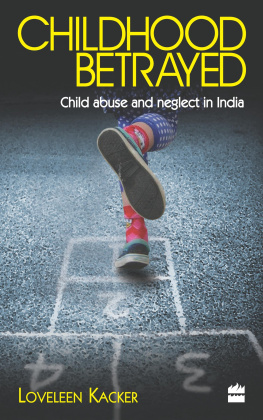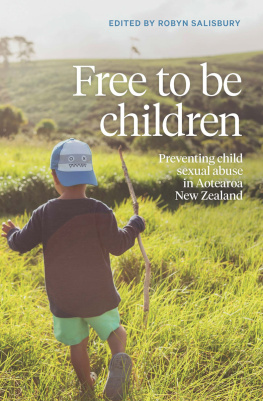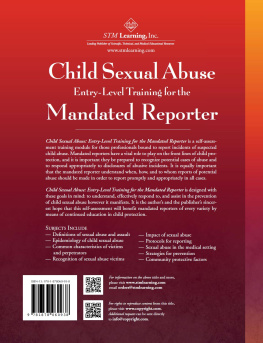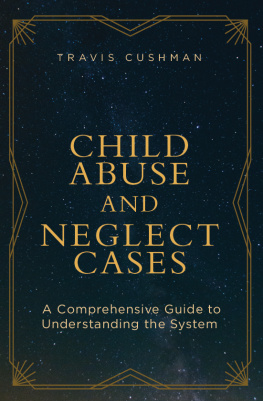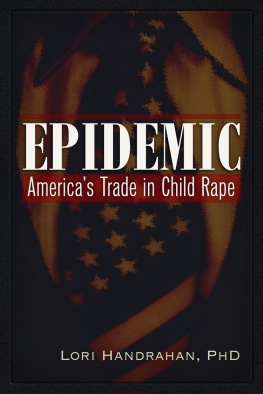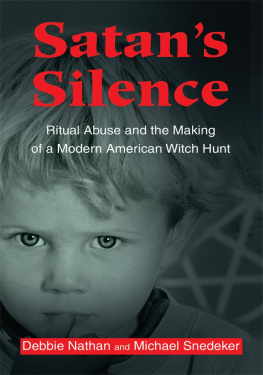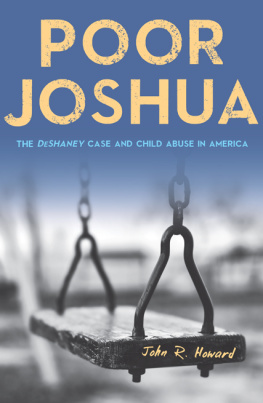Contents
Guide
Page List
The Witch-Hunt Narrative
The Witch-Hunt Narrative
The Witch-Hunt Narrative
Politics, Psychology, and the Sexual Abuse of Children
Ross E. Cheit
Illustrations by L. Arthi Krish naswami


Oxford University Press is a department of the University of Oxford. It furthers the Universitys objective of excellence in research, scholarship, and education by publishing worldwide.
Oxford New York
Auckland Cape Town Dar es Salaam Hong Kong Karachi
Kuala Lumpur Madrid Melbourne Mexico City Nairobi
New Delhi Shanghai Taipei Toronto
With offices in
Argentina Austria Brazil Chile Czech Republic France Greece
Guatemala Hungary Italy Japan Poland Portugal Singapore
South Korea Switzerland Thailand Turkey Ukraine Vietnam
Oxford is a registered trade mark of Oxford University Press in the UK and certain other countries.
Published in the United States of America by
Oxford University Press
198 Madison Avenue, New York, NY 10016
Ross E. Cheit 2014
All rights reserved. No part of this publication may be reproduced, stored in a retrieval system, or transmitted, in any form or by any means, without the prior permission in writing of Oxford University Press, or as expressly permitted by law, by license, or under terms agreed with the appropriate reproduction rights organization. Inquiries concerning reproduction outside the scope of the above should be sent to the Rights Department, Oxford University Press, at the address above.
You must not circulate this work in any other form and you must impose this same condition on any acquirer.
CIP data is on file at the LOC
9780199931224
1 3 5 7 9 8 6 4 2
Printed in the United States of America on acid-free paper
CONTENTS
Just as this book was being completed, the scandal that has come to be associated with Penn State took a definitive turn. Gerald Jerry Sandusky, the football teams defensive coordinator for many years, was convicted of forty-five counts of sexual crimes against children. Soon thereafter, the Freeh Report concluded that four of the most powerful people at the university, including Coach Joe Paterno, had covered up the situation and exhibited a striking lack of empathy for Sanduskys victims. The NCAA quickly imposed severe sanctions, which included a penalty that would provide millions of dollars for child abuse prevention programs. It is, no doubt, the most important child sexual abuse story in recent years. One particular aspect of the story shocked the sensibilities of many: Mike McQueary testified that when he was a graduate assistant at Penn State he saw Jerry Sandusky in the shower with a boy who Sandusky appeared to be subjecting to a sexual assault. McQueary reported the incident to Coach Paterno. Although there are differing accounts about precisely what McQueary said, there is no disagreement about the fact that nobody higher up in the university contacted law enforcement. The criminal trial established that Sandusky sexually abused several more boys after top officials at the university had more than sufficient reason to report him.
What surprised me most about the Penn State storyafter spending fifteen years researching and writing this bookwas that so many people were flabbergasted that a cover-up like this could occur. Everyone knows, of course, about the massive cover-up of similar events in the Roman Catholic Church. Indeed, a few commentators were quick to draw parallels between the cases by casting football as religion and coach Paterno as the pope. But while we have overcome our collective denial about the possibility that a priest could abuse a child, we have also managed to compartmentalize the lessons from the Catholic Church cases, an issue to which I will return at the end of the book.
rallying around a convicted child rapist is not at all unusual.
The second reason the events at Penn State did not surprise me stems directly from the argument of this book. We have, over the last twenty years, discounted the word of children who might testify about sexual abuse. We have become more worried about overreacting to child sexual abuse than we are about underreacting to it. The Penn State case is filled with concern on the part of administrators about whether Sandusky was being treated humanely, with little or no apparent regard for his possible victims. We are far too quick to dismiss the word of a child these days in the name of worrying about child suggestibility. This developmentunlike our contradictory views about sex offenses in general versus sex offenders in particularis recent. Ironically, an overly dismissive view of children is a function of the very cases that opened the doors to allowing younger children to testify in the first place. Those cases occurred in the 1980s; many of them became infamous, and many were later overturned on appeal. All of those cases have since been cast as wrongful accusations or wrongful convictions, thanks in large part to claims about child suggestibility. Notably, the successful case against Sandusky was built on the testimony of people who were children at the time of the incidents. All were male and at least eighteen at the time they testified. The case might well have come out differently had the facts been the same but the witnesses all adolescents or younger at the time of their testimony.
This book challenges the argument that our society overreacted to the sexual abuse of children and, in the process, engaged in series of witch-hunts in the 1980s. Based on the first comprehensive examination of trial court records from those cases, this book argues that the witch-hunt narrative does not do justice to the facts of these cases. The very cases that have been used to justify the claim that children are highly suggestible demonstrate how easy it is to make the claim regardless of the evidence. This book does not, however, claim that every controversial conviction from the 1980s was rightly decided, or that every reversal on appeal was misplaced. Rather, it questions the much more extreme claim that there were hundreds or thousands of injustices during this time that were akin to the Salem witch trials. In my view, there were some injustices during this period that merit serious concern. Several are detailed in this book. But to claim that those cases define a whole period is to adopt a view not borne out by the evidence.
The research for this book began with the investigation of a single case. At the time, I thought I was writing a book review of Satans Silence: Ritual Abuse and the Making of an American Witchhunt, by Debbie Nathan and Michael Snedeker. The book argues that scores of injustices, akin to the Salem witch trials, were perpetrated around the country in the 1980s through prosecutions for child sexual abuse. The book was dedicated to the men and women still incarcerated, including those whose names we know, followed by a two-column list of proper names, along with place names in parentheses. Surprisingly, many of those identified on the dedication page were not mentioned in the book; several others were referenced in the book but in no more than a sentence or two. It struck me as strange that the very cases allegedly constituting the strongest and most concrete evidence of a nationwide series of witch-hunts would receive so little attention in a book on the very subject. On closer examination, it appeared that only a few of the cases on the dedication page had been the subject of original research. Although the witch-hunt narrative often refers to hundreds of these cases, the same handful of cases are at the core of most publications. Three of them, beginning with McMartin and including Kelly Michaels and Frank Fuster, are the subject of detailed chapters ahead. Before getting to the merits of those cases, however, one might wonder why an allegedly national wave of witch-hunts is routinely illustrated by stories about the same handful of cases.


